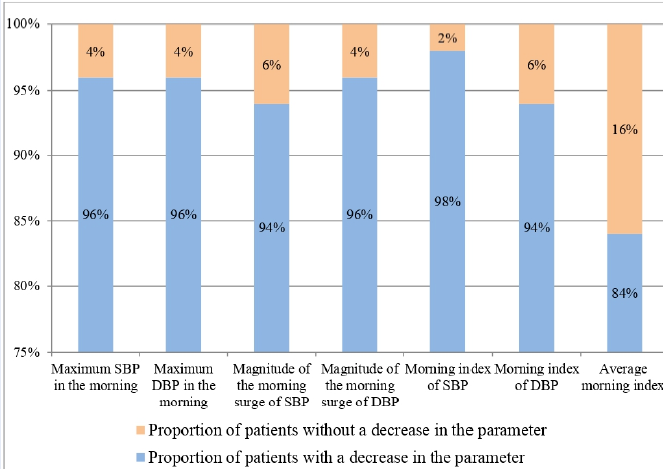Clinical and functional predictors that cause a decrease of indicators of morning blood pressure profile in antihypertensive telmisartan-based therapy
DOI:
https://doi.org/10.15419/bmrat.v7i9.630Keywords:
Arterial hypertension, ambulatory blood pressure monitoring, blood pressure, telmisartan, antihypertensive therapyAbstract
Background: Blood pressure (BP) monitoring is an important aspect in the treatment of arterial hypertension (AH), namely the morning BP increase which is associated with an increased risk of cardiovascular and cerebrovascular incidents as well as sudden death. The study herein revealed clinical and functional predictors which decrease the morning BP rise in the case of optimal antihypertensive therapy with telmisartan, based on results of daily blood pressure monitoring (DBPM).
Methods: A single-center open-label study in parallel groups was conducted. The study included 50 patients with AH who had previously received antihypertensive therapy but did not achieve a reduction in BP according to DBPM. Telmisartan (40 - 80 mg per day) was added to the treatment regimen of all patients. All patients underwent a general clinical examination, measurement of glucose and creatinine levels, assessment of lipid profile, ECG recording in 12 leads, echocardiography (EchoCG), and DBPM before treatment and after 12 weeks of treatment. Statistical data analyses were performed.
Results: Twelve-week antihypertensive telmisartan-based therapy led to a decrease in mean systolic blood pressure (SBP) from 134.3 ± 5.0 to 126.2 ± 4.3 mm Hg (p = 0.008), and a decrease in mean diastolic blood pressure (DBP) from 79.8 ± 1.5 to 73.0 ± 1.4 mm Hg (p < 0.001). There was a decrease in the index of variability of DBP from 22.4 ± 2.8 to 16 ± 2.4 mm Hg (p < 0.001), and a decrease in the daily index of SBP from 15.7 ± 4.7 to 13.1 ± 4.7 mm Hg (p = 0.014). In the study, a connection was found between the decrease of the average morning index and the following indicators: presence of left ventricular (LV) hypertrophy on ECG, final diastolic size of the LV over 6.0 cm, LV ejection fraction below 52.3%, total cholesterol level over 5.5 mmol/L, LDL level greater than 3.3 mmol/L, and triglyceride level greater than 2.0 mmol/L.
Conclusion: These values could be used as predictors of a decrease in the morning index during 12-week telmisartan therapy.

Downloads
Published
Issue
Section
License
Copyright The Author(s) 2017. This article is published with open access by BioMedPress. This article is distributed under the terms of the Creative Commons Attribution License (CC-BY 4.0) which permits any use, distribution, and reproduction in any medium, provided the original author(s) and the source are credited.
